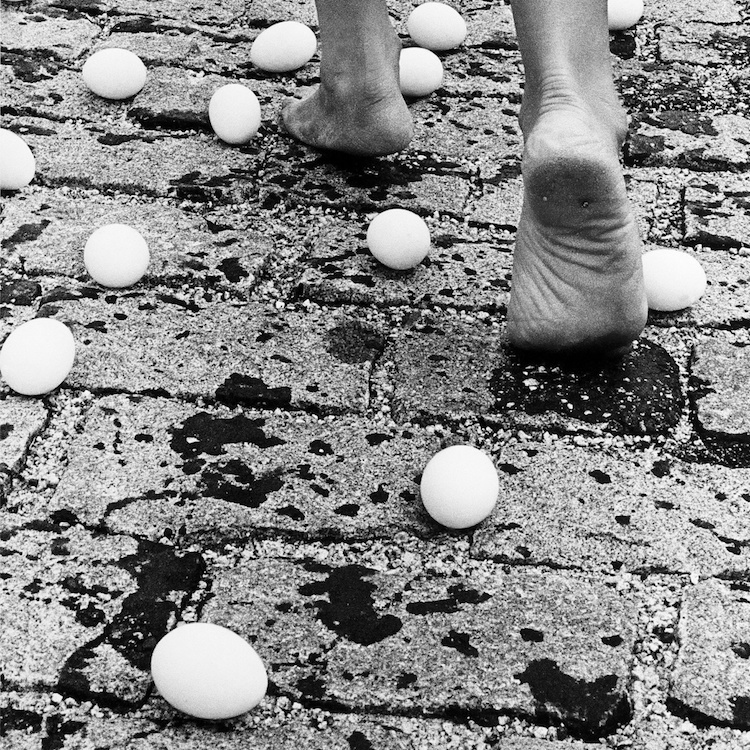LOS ANGELES— Mounds of oversized hand-rolled, unfired coils, braids and vermiform objects are at the center of Italian-born Brazilian artist Anna Maria Maiolino‘s first U.S. retrospective exhibition at MOCA Grand Avenue this fall (August 4–December 31, 2017). The exhibition brings together works from the influential artist’s five decades-long career; from her expressive woodblock prints, fluid drawings and visceral cement sculptures, to her politically-charged films and performances and large ephemeral installations of unfired clay.

Installation view of Anna Maria Maiolino

Installation view of Anna Maria Maiolino

Installation view of Anna Maria Maiolino
Maiolino’s wall-mounted art works of gouged plaster set the stage for her dramatic new installation Estão na Mesa. According to The New York Times, she hand formed, rolled and coiled hundreds of clay cylinders, crescents and braids, which she then presented on a simple wooden table. On the floor, she hand-formed two large heaps of oversized clay coils, which the Times described as like extruded taffy, piles of pasta, delicious tarralucci cookies and even excrement.
The metaphor of alimentation exceeds easy decoding — yet these late clay and plaster works are engaged with the discrepancies between individual and social life. They are personal and yet systematic, fragile and yet nourishing. And they are masterworks.
Maiolino also created tubular loaf-like logs and stout coil towers juxtaposed to wormy coils along the wall.

Installation view of Anna Maria Maiolino

Installation view of Anna Maria Maiolino
The exhibition, as a whole, traces the course of Brazilian art history and major postwar movements, channeled through Maiolino’s introspective practice exploring and charting her identity as a migrant, mother and global citizen “as much as it opens on to large philosophical questions of repetition and difference, the transient and the permanent, and aesthetic problems such as solid and void and the intimate relationship between drawing and sculpture.”

Installation view of Anna Maria Maiolino

Installation view of Anna Maria Maiolino

Installation view of Anna Maria Maiolino

Installation view of Anna Maria Maiolino

Installation view of Anna Maria Maiolino
Maiolino moved to Brazil as teenager in 1960 to attend the Escola Nacional de Belas Artes in Rio de Janeiro, where her work was profoundly influenced by the aftermath of WWII, repression during Brazil’s 20-year military dictatorship and the challenging of canonical thinking in art.
As a young artist, living under Brazil’s military government, she used painting, photography, video and paper collage to express her anxieties under the regime and her displacement in the New World, as well as her identity as a mother and daughter. Later, in a democratic Brazil, she made equally poignant drawings and works in clay and plaster, which explore more elemental themes of hunger and nourishment, ritual and obsession.

Installation view of Anna Maria Maiolino

Installation view of Anna Maria Maiolino
According to her artist bio, she, along with fellow art students Antonio Dias and Rubens Gerchman (her future husband), would develop a hot-colored style known as Nova Figuração, a figurative revival, which developed during the era of political and social turbulence. For Dias, Gerchman and Maoilino, their work directly contested the junta, which took power of Brazil in 1964.

Anna Maria Maiolino (center)
Anna Maria Maiolino is part of The Getty Foundation’s Pacific Standard Time: LA/LA initiative, hosted by arts institutions across Southern California and exploring Latino and Latin American Art in dialogue with the city of Los Angeles. In its second reiteration, the foundation awarded $8.45 million in grants to 43 participating cultural institutions to produce a region-wide festival of exhibitions from San Diego to Santa Barbara.
Images courtesy of The Museum of Contemporary Art, Los Angeles; photography: Brian Forrest.

Installation view of Anna Maria Maiolino

Installation view of Anna Maria Maiolino

Installation view of Anna Maria Maiolino
Do you love or loathe this exhibition of contemporary ceramic art and contemporary ceramics? You what we think, now we want to hear from you.

A discovery… Thanks!